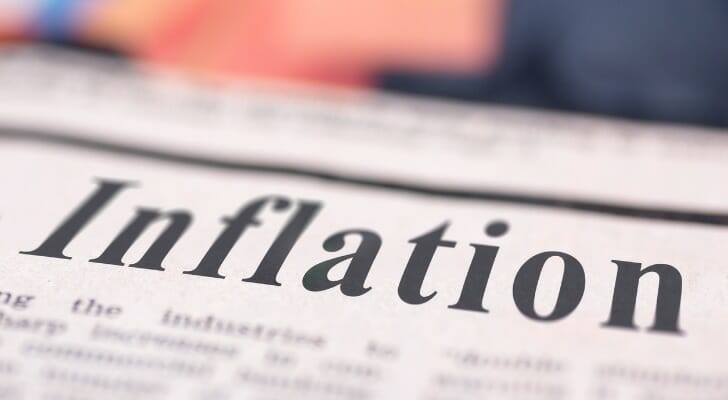By the end of July 2021, the price of gasoline had surged almost 42% over the previous 12 months and the price of used vehicles spiked at nearly the same rate. While skyrocketing prices of these two commodities are the most dramatic examples of rising prices in today’s economic environment, they illustrate a simple truth: inflation is soaring.
The Consumer Price Index (CPI), which measures the change in prices paid by consumers for goods and services, increased 5.4% during the 12-month period that ended in July 2021, and the same for the 12-month period ending in June 2021. Fueled by massive consumer spending and supply chain bottlenecks, national inflation is at its highest level since July 2008 when the CPI rose 5.6% from a year earlier. In fact, between 1990 and 2020, inflation grew by only 2.4% per year, far below the current year’s pace. With so much attention on inflation, SmartAsset set out to determine the places in the U.S. where the price of goods and services has spiked the most.
Data and Methodology
To find out where inflation has spiked the most, we examined all 23 U.S. metro areas with available data from the Bureau of Labor Statistics’ Consumer Price Index. However, data for each metro area is not released every month. As a result, the most recent changes in the CPI for 11 metro areas are for the 12-month period ending June 2021, while the rest are as of the 12-month period ending July 2021.
Key Findings
- Inflation is highest in the Atlanta, Georgia metro area. The Atlanta-Sandy Springs-Roswell metro area saw the price of goods and services jump 6.7% in the 12-period that ended in June 2021. This is the highest increase of all 23 metro areas for which BLS data is available.
- High cost of living areas have been impacted the least. New York, New York; San Francisco, California and Los Angeles, California may be known for their high costs of living, but inflation spikes in these metro areas have been among the lowest across large metro areas. San Francisco has seen the smallest 12-month inflation spike – just 3.2% as of June 2021.

Places With the Largest Inflation Spikes
While the CPI increased 5.4% over the 12-month period ending in July, inflation rates in nine metro areas across the country exceeded that national average. In Atlanta, Georgia, a 59.3% spike in gasoline prices helped push the overall CPI up 6.7% for the 12-month period that ended in June.
Consumer prices in the Tampa-St.Petersburg-Clearwater, Florida spiked 6.6% for the 12 months ending in July, the second-largest CPI increase of all 23 metro areas. Food prices in Tampa-St. Petersburg-Clearwater rose 4.3% during the same time period.
In California, the Riverside-San Bernardino-Ontario metro area saw consumer prices jump 6.5% during the 12-month period that ended in July. A 37.5% increase in gasoline prices pushed the overall price of energy up nearly 27% during that span. The CPI also increased by 6.5% in the Minneapolis-St. Paul-Bloomington metro area, where the price of used motor vehicles jumped 19.2% for the 12 months ending in July.
Meanwhile, the CPI advanced 6.2% in the Anchorage, Alaska area for the 12 months ending in June, the fifth-largest increase in the country. During that time, the price of used cars and trucks in Anchorage surged 42.1%.
Places With the Smallest Inflation Spikes
Consumer prices in the San Francisco-Oakland-Hayward metro area rose only 3.2% year-over-year in June, the lowest inflation rate out of all 23 metro areas tracked by the BLS. Across the New York and Denver metro areas, prices rose 3.5% during the 12-month period that ended in July, which is tied for the second-smallest CPI increase in the U.S.
The Los Angeles-Long Beach-Anaheim metro area saw prices jump 3.9% in the 12 months ending in July, while the Boston-Cambridge-Newton area had a 4.3% jump in its CPI during the same span of time, which is fifth-lowest across all 23 metro areas.
Tips for Hedging Against Inflation
- Consider investing in TIPS. Treasury Inflation-Protected Securities or TIPS are U.S. government fixed-income securities that mirror the rate of inflation and can serve as an effective hedge. TIPS typically come in 5-, 10- or 30-year terms, and pay out interest twice a year.
- Short-term bonds are also an option. Since interest rates typically rise with inflation, long-term fixed-income securities tend to lose value. However, short-term fixed-income securities – including bonds – may offer better returns. This is due to the fact that as rates rise, new bond issues reflect the current interest environment.
- Owning real estate. Because the value of real estate also tends to rise in an inflationary environment, owning property or investing in a real estate investment trust (REIT) are also thought of as viable strategies to hedge against inflation. Check out our recent study on the best cities to invest in long-term rental properties, if you are thinking of leasing a home or apartment.
- Work with a professional. A financial advisor can help you manage your investments during times of elevated inflation. SmartAsset’s free matching tool can connect you with up to three advisors in your area in as little as five minutes. If you’re ready to find a local professional, get started now.
Questions about our study? Contact us at press@smartasset.com.
Photo credit: ©iStock.com/CasPhotography
